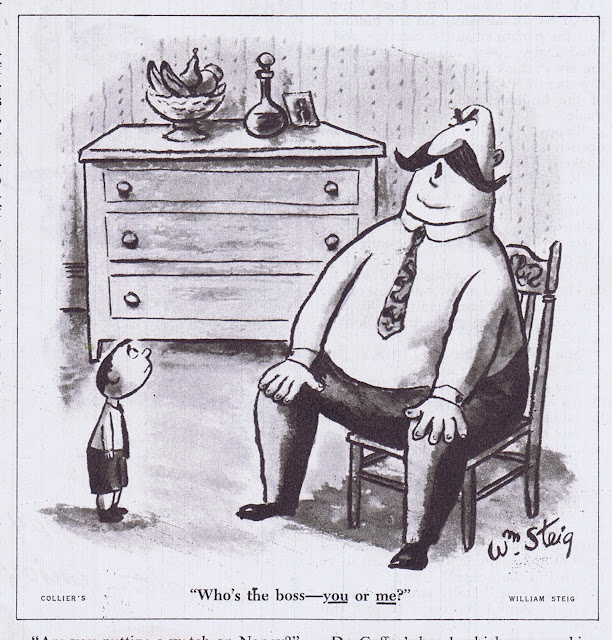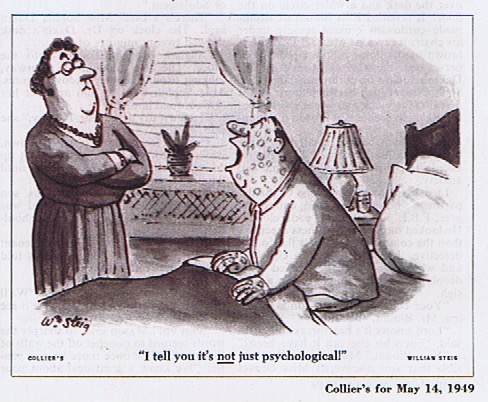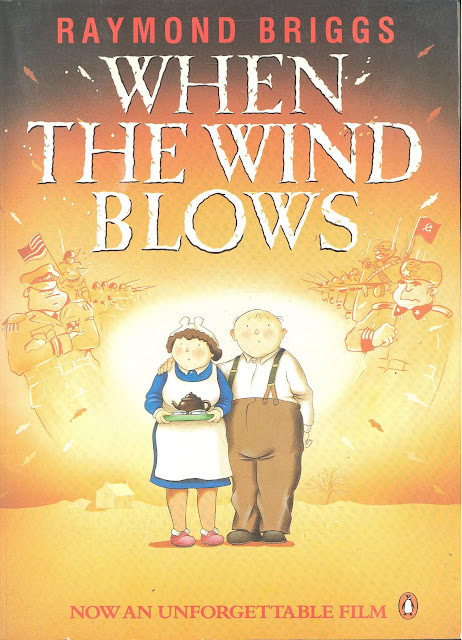Hat tip to Sarah Booth for this great 1973 BBC Archive documentary news clip.
Tuesday, April 30, 2024
Monday, April 29, 2024
Cartoons from WIT FROM OVERSEAS Edited by Roy H. Hoopes, Jr.
WIT
FROM OVERSEAS, is a collection of wit (cartoons and prose) from various
foreign periodicals. It's edited by Roy H. Hoopes, Jr. and is (I swear
to goodness) copyright: 1950, 1951, 1952 by Farm Journal, Inc.; 1952 by
Hulton Press, Ltd.; 1950, 1951 by The Elite Publishing Corp.; 1950,
1951, 1952 by Bradbury, Agnew, Ltd.; 1953 by Roy H. Hoopes, Jr.
I
don't know the work of most of these cartoonists, so please excuse my
ignorance. I'd love to hear from someone who may know more than I do about them.
Above: I love the old robots: all boxy, with
knobs and gears and sometimes an old fashioned lightbulb for a nose. The
cartoonist added that great big wind-up mechanism in back and it just
is a wonderful gag. The smug reaction on the bearded scientist tells you
that the poor robot is right.
Above:
the drawing makes the gag. Click to really supersize the cartoon. Look
at that detail! Look at all that patience to get it all looking right.
The
above cartoon COULD be the way it all works. Maybe there's this WHITE
CONCRETE, y'know? I recall an episode of the British comedy series THE
GOODIES wherein one of the Goodies guys is making an old time black and white
movie, and he truly believes that he must paint everything within camera
range with black or white paint. Above:
you get a great feel for the space in the compartment. Yeah, it's a
potty joke -- but one that's clever, and, international -- since it's
wordless.
Above:
you get a great feel for the space in the compartment. Yeah, it's a
potty joke -- but one that's clever, and, international -- since it's
wordless.
Above: Just look at the cartoonist's command of perspective and excellent reference. And this was before Google images!
Above: a creepy one that would plague me if I saw it when I was a tot. What kind of product are those statue heads using?
Above:
some gorgeous work by a Mexican cartoonist. If anyone knows who the
cartoonist is, please drop a line. Note to Mr. Hoopes: this wit is not
from overseas, since Mexico is part of the North American landmass.
Above: a silly and twisted little cartoon. Who knew that umbrellas were so prim and proper!
Chaval
is a name that I see a lot -- but I know nothing of the human being
behind the pen. His bold, wordless gags work so well because they're all
rooted in human behavior. Not necessarily the kind of behavior that
would win you a merit badge, but human behavior nonetheless.
Above: the cartoonist Wiles (?) puts together this grand vertical composition with exacting precision.
It's the appearance of that one high heel -- and leaving their view to the imagination -- that makes this one so successful.
Above: a silly gag, but one full of good drawing: the watery squiggles, the spritzing leak, the Commander in full Napoleon pose.
Not only that, the divan looks like it's floating! An eerie cartoon that smacked of Edward Gorey or William Steig.
Above: life before the Internet. A sharply drawn cartoon by Starke, whose work I've seen in some other UK collections.
Above: another great silent gag, with just enough detail for you to see what's going on.
Chaval with another winner. Are there really big trucks, lugging wine all over France?
Above: a silly cartoon by some youngster named Ronald Searle!
- Edited from a blog entry of March 11, 2008.
Friday, April 26, 2024
Iconic 1982 Patrick Nagel Print Based on Model Eva Voorhees
Doesn't this just scream 1980s?! This well known fashion print -- something I have seen for decades in salons all over the USA -- was created by Patrick Nagel (1945 - 1984). Nagel may be best known for his Duran Duran record covers, as well as his work for Playboy magazine.
What I didn't know until now is that Nagel's print here is based on a 1982 photo of a model named Eva Voorhees:
Voorhees was a rarity: a popular American model of the time who had brunette hair.
She wrote a book about her life in 2007: Live Through This: A Mother's Memoir of Love and Loss.
She had a busy modeling career, and overcame family abuse (read her book), becoming an iconic model. Last I could tell, she wanted to create a site paying tribute to the models of the 1970s and 80s "and then some." She wrote this on the Bellazon board in 2008:
---
To my Bellazon friends:
Thank you from the bottom of my heart! I'm playing catch up to all you proficient Bellazon users, but I will get to your level and learn how to maneuver through this site, hopefully!
I am so grateful for your generosity and assistance in this monumental task. It will be like nothing else-I'm sure of it! Every 70's-80's (and then some) model will have her own album and as much information as possible when the site is expanded to include more than just photographs.
I made 60 albums with my collection of tear sheets. Now, with generous contributions from some of you, I can do justice to a number of models whose albums were nearly empty.
Any contributions you can make to the site would be invaluable. With your assistance I can keep alive the memory and body of work of so many adored models.
I read a post that was called the forgotten models on here once. It was while I was making my site, and all I could think was: I can't wait to go here and let everyone know they are not forgotten! And you could help me keep their memory alive and well. I hope you will visit the site: www.supermodelsofthe70s-80s.org and contribute anything you can. If you have bios, updates, articles, videos, websites, etc., the site is the place where all that information will be kept!
Thank you all for even considering to help me, and for those of you who already have: I am truly touched by your kindness and patience with me. You're the best!
I look forward to this exciting and limitless undertaking!
Most sincerely,
Eva Voorhees
---
Unfortunately, neither of those sites are working.
Thursday, April 25, 2024
From the Dick Buchanan Files: William Steig Gag Cartoons 1946 - 1965
Here are fifteen gag cartoons by the great William Steig. All have been lovingly clipped, scanned and cleaned up by Dick Buchanan. My thanks to you and -- take it away, Dick:
---
WILLIAM STEIG GAG CARTOONS
1946 – 1965
William Steig was a cartoonist and sculptor as well as a renowned children’s books author and illustrator. He sold his first carton to Judge in 1930, soon followed by his first sale to The New Yorker. Over the next 73 years The New Yorker would publish 1600 of his drawings and 121 covers—that’s more than two years of covers.
Today Steig is perhaps best known as the author and illustrator of series of books for children. His Sylvester and the Magic Pebble was awarded the Caldecott Medal. It was followed by Abel’s Island, Doctor De Soto and many more, including Shrek! They are all marvelous books for children and adults alike.
These are William Steig gag cartoons from the era when he was hailed as “The King of Cartoons.” It’s a sampling of his drawings from Collier’s and Look Magazine from 1946 to 1965 . . .
1. Collier’s February 16, 1946.
2. Collier’s February 16, 1946.
3. Collier’s August 14, 1948.
4. Collier’s May 14, 1949.
5. Collier’s December 31, 1949.
6. Collier’s March 11, 1950.
7. Collier’s July 22, 1950.
8. Collier’s August 19, 1950.
9. Collier’s May 11, 1956.
10. Look February 3, 1959.
11. Look February 17, 1959.
12. Look September 15, 1959.
13. Look May 10,1963.
14. Look January 15, 1963.
15. Look August 10, 1965.
Wednesday, April 24, 2024
BBC Archive: Raymond Briggs Talks About His Graphic Novel "When the Wind Blows" (1983)
When the Wind Blows by Raymond Briggs was first published as a graphic novel in 1982. It's "known for its critiques against government issued preparations for nuclear war. Utilizing a cartoonish design, this graphic novel follows a retired couple, Jim and Hilda Bloggs, and their journey through surviving a nuclear attack on Britain launched by the Soviet Union. The novel was later adapted for different entertainment types including an animated film, radio play, and stage play" - Wikipedia.
Here's Mr. Briggs, in 1983, talking to the BBC about the book and its aims. It was not a "protest book," says Briggs, but a "human story." The short video includes some peeks at his studio, as well as a look at the recording of the book as a radio play starring Peter Sallis and Brenda Bruce. It was just released on the BBC Archive channel.
Tuesday, April 23, 2024
Complete Guide To Cartooning by Gene Byrnes (1948)
The Complete Guide to Cartooning by Gene Byrnes is available at Archive.org, and do take a look at the Animation Resources site, which has hi res scans and more detail about this how to cartoon book, which features "157 Outstanding Artists."
The author, Gene Byrnes (1889 - 1974), created the long running Reg'lar Fellers syndicated comic strip (1917 - 1949). He had planned a career in sports, but broke his leg during a wrestling match. While convalescing, he copied cartoons by Tad Dorgan. Then he took the Landon Course. After meeting Winsor McCay, he applied for and received a position as sports cartoonist at the New York Telegram on his recommendation.
He drew a couple of cartoon features at the Telegram, with names like Things That Never Happen, Wise Awake Willie and It's A Great Life If You Don't Weaken. That last one featured a couple of the kid characters that would star in Reg'lar Fellers.
Via Wikipedia:
His Complete Guide to Cartooning was influential on a generation of comic artists, including Ralph Bakshi.
Below are some sample images.


































